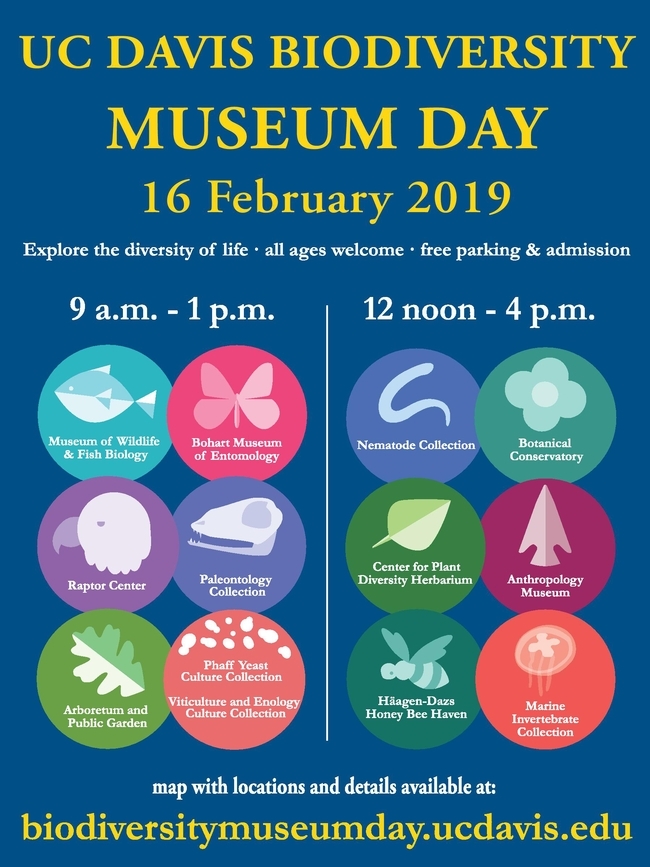
You won't want to miss the eighth annual UC Davis Biodiversity Museum Day, set from 9 a.m. to 4 p.m., Saturday, Feb. 16. The free, family friendly event will feature 13 museums or collections.
Have you ever seen a chocolate tree loaded with fruit? Or a plant that folds its leaves when you touch it? No? Ever seen a Humboldt squid, a giant predator that's also known as a jumbo squid? How about a Peruvian sling shot? Or fossils more than 550 million years old?
No? Ever watched scientists prepare a bobcat specimen for display? Or taken a selfie with a red-tailed hawk? Or petted a stick insect or a pine cone? How about kombucha tea--ever tasted it?
You can do that and more at the UC Davis Museum Day. All are within walking distance except for the Häagen-Dazs Honey Bee Haven on Bee Biology Road and the Raptor Center on Old Davis Road. The hours vary from 9 a.m. to 1 p.m. and from noon to 4 p.m.
The science-based event, exploring the diversity of life, drew more than 4000 visitors to the campus last year, according to Tabatha Yang, education and outreach coordinator for the Bohart Museum of Entomology.
New this year is the Marine Invertebrate Collection in the Sciences Laboratory Building, off Kleiber Hall Drive. “Visitors can expect to see specimens collected from Oahu and Baja California, and live corals,” said spokesperson Ivani Li. “There will be a touch tank. At some point there will be a brief presentation about squids where we will be showing off our Humboldt Squid or jumbo squid.”
The UC Davis Biodiversity Museum Day, always held the Saturday of Presidents' Day weekend, is billed as a “free, educational event for the community where visitors get to meet and talk with UC Davis scientists from undergraduate students to staff to emeritus professors and see amazing objects and organisms from the world around us.” Parking is also free. Maps are available on the Biodiversity Museum Day website at http://biodiversitymuseumday.ucdavis.edu/.
These seven collections will be open from 9 a.m. to 1 p.m.:
- Arboretum and Public Garden, Good Life Garden, next to the Robert Mondavi Institute, 392 Old Davis Road, on campus
- Bohart Museum of Entomology, Room 1124 of the Academic Surge Building, Crocker Lane
- California Raptor Center, 340 Equine Lane, off Old Davis Road
- Museum of Wildlife and Fish Biology, Room 1394, Academic Surge Building, Crocker Lane
- Paleontology Collection, Earth and Physical Sciences Building, 434 LaRue Road
- Phaff Yeast Culture Collection, Robert Mondavi Institute of Wine and Food Science, 392 Old Davis Road, on campus
- Viticulture and Enology Culture Collection, Robert Mondavi Institute of Wine and Food Science, 392 Old Davis Road, on campus
The following will be open from noon to 4 p.m.:
- Anthropology Museum, 328 Young Hall and grounds
- Botanical Conservatory, Greenhouses along Kleiber Hall Drive
- Center for Plant Diversity, Sciences Laboratory Building, off Kleiber Hall Drive
- Häagen-Dazs Honey Bee Haven, Bee Biology Road, off Hopkins Road (take West Hutchison Drive to Hopkins)
- Nematode Collection, Sciences Laboratory Building, off Kleiber Hall Drive
- Marine Invertebrate Collection, Sciences Laboratory Building, off Kleiber Hall Drive
All participating museums and collections have active education and outreach programs, Yang said, but the collections are not always accessible to the public. Maps, signs and guides will be available at all the collections, and also online at http://biodiversitymuseumday.edu, and on social media, including Facebook and Twitter, @BioDivDay.
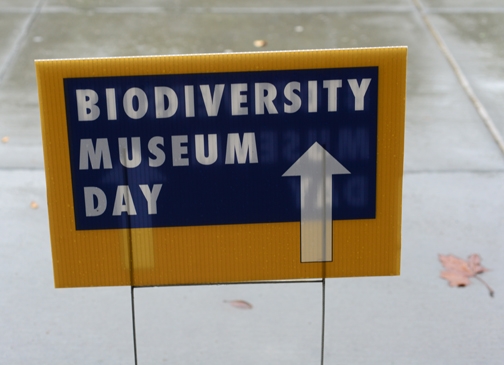
Arboretum and Public Garden
The Arboretum and Public Garden will present “investigation stations” from 9 a.m. to 1 p.m. at the Good Life Garden, next to the Robert Mondavi Institute, 392 Old Davis Road, on campus. Visitors will learn about the importance of bees, hummingbirds and moths as pollinators. They can play fun games, and color and craft their own pollinator pets.
Bohart Museum of Entomology
The Bohart Museum of Entomology, located in Room 1124 of the Academic Surge Building on Crocker Lane, will be open from 9 a.m. to noon, The Bohart is the home of a world-class collection of nearly 8 million insect specimens. Insect scientists will meet with the public to help them explore insects and spiders (arachnids). Highlights will include the 500,000-specimen butterfly/moth collection, curated by entomologist Jeff Smith. The Bohart maintains a live “petting zoo,” comprised of Madagascar hissing cockroaches, walking sticks and tarantulas.
California Raptor Center
The California Raptor Center, located at 1340 Equine Lane, Davis, just off Old Davis Road, will be open from 9 a.m. to 1 p.m. Visitors will see a living collection of non-releasable raptors, including hawks, owls and a golden eagle. The center's educational ambassador birds will be out "on the fist", so visitors can get a close look and talk to the volunteers about the birds of prey that live in this area.
Museum of Wildlife and Fish Biology
The Museum of Wildlife and Fish Biology, located in Room 1394 of the Academic Surge Building, Crocker Lane (off LaRue Road) will be open from 9 a.m. to 1 p.m. “We're planning an action packed morning with displays highlighting carnivores, bats, reptiles and fish,” said director Andrew Engilis Jr. “There will be specimen preparation demos (bobcat and raptors) as well as a kid crafts table.”
Paleontology Collection
The Paleontology Collection, located in the Earth and Physical Sciences Building, 434 LaRue Road, will be open from 9 a.m. to 1 p.m. Visitors can view fossil specimens dating from as old as 550 million years ago to more recent animal skeletons. Paleontology graduate students in invertebrate and vertebrate paleontology will answer questions and provide interesting factoids.
Phaff Yeast Culture Collection and Viticulture and Enology Culture Collection
These collections will be open from 9 a.m. to 1 p.m. in the Robert Mondavi Institute,392 Old Davis Road, on campus. Visitors can learn about the importance of microbes in research, biotechnology, and food and beverages, and about the proud history of two of the world's prominent microbe collections.
Visitors can
- Tour the UC Davis teaching winery and brewery
- See and smell dozens of yeast species
- Use microscopes to look at yeast cultures
- Learn how yeasts and bacteria are important for making fermented foods and beverages
- Taste vegemite, marmite, and kombucha tea
- Hear how to make clothes from yeast and bacteria
- Hear about cutting edge research using these microbe collections and
- Listen to yeast jokes
Anthropology Museum
The Department of Anthropology Museum, located in 328 Young Hall, will be open from noon to 4 p.m. The Anthropology Museum curates collections of archaeological, ethnographic, biological and archival materials. Visitors will:
- See how different peoples around the world incorporate biodiversity into personal adornment
- Learn about how the native peoples of the Central Valley made use of the area's biodiversity
- Find out what our hominin ancestors looked like
- Explore the anatomical diversity of our primate relatives
- Learn to throw a spear with an atlatl or use a Peruvian sling shot to hit your target
- Learn how to make stone tools by flintknapping
- Explore how archaeologists identify the various animals people used for food, tools, and clothing
The Botanical Conservatory
The greenhouses in the Botanical Conservatory on Kleiber Hall Drive will be open from noon to 4 p.m. Visitors can expect to see carnivorous plants; a chocolate tree loaded with fruit; succulents and other desert plants including the Madagascan spine forest plants that lemurs climb on; the giant leaves of the Titan arum plant, and Mimosa pudica aka sensitive plant whose leaves fold up when touched, said collections manager Ernesto Sandoval. “And, weather permitting, we'll encourage visitors to stroll the paths of the Biological Orchard and Gardens--an outdoor extension of Botanical Conservatory's role in undergraduate education at UC Davis.”
Center for Plant Diversity Herbarium
The Center for Plant Diversity Herbarium, located in Room 1026 of the Sciences Laboratory Building, central campus (off Kleiber Hall Drive), will be open from noon to 4 p.m.. Curator Ellen Dean said visitors can tour the collection area, see plant pressing and mounting demonstrations, “pet our plant zoo” (a table showcasing the diversity of plants, including mosses, pine cones, ferns and flowering plants); look and plants under a microscope, and view oak exhibit. The children's activity? Making herbarium specimens.
Häagen-Dazs Honey Bee Haven
Häagen-Dazs Honey Bee Haven, a half-acre bee demonstration garden located next to the Harry H. Laidlaw Jr. Honey Bee Research Facility, Bee Biology Road, will be open from noon to 4 p.m.. “The focus this year will be the link between bee health and human health through effective crop pollination and an overview of our research into bee plant preferences for common garden plants,” said manager Chris Casey. Also planned is a catch-and-release activity in which youths catch bees with a vacuum device, view them, and then release them. A six-foot long sculpture of a worker bee by artist Donna Billick of Davis anchors the haven, which was planted in the fall of 2009.
Nematode Collection
The nematode collection will open from noon to 4 p.m. in the Science Laboratory Building, (off Kleiber Hall Drive. It will feature both live and slide-mounted nematodes, as well as jars of larger parasites. Nematodes, also called worms, are described as “elongated cylindrical worms parasitic in animals or plants or free-living in soil or water. They exist in almost every known environment.”
Marine Invertebrate Collection
The Marine Invertebrate Collection will open from noon to 4 p.m. in the Science Laboratory Building, off Kleiber Hall Drive. Visitors can view specimens collected from Oahu and Baja California, and live corals. There also will be a touch tank and Humboldt squid presentation.
Attached Images:
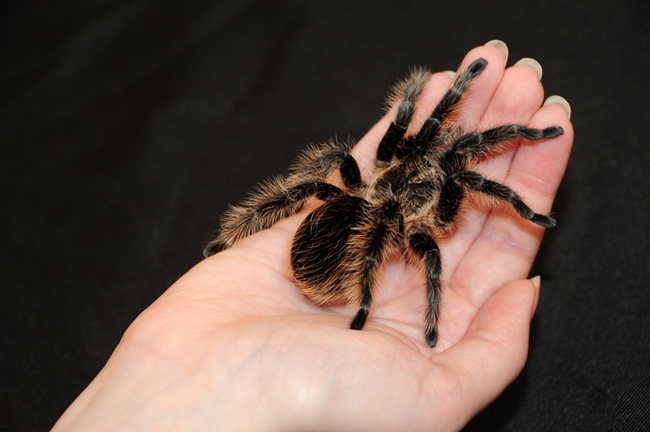
A tarantula at the Bohart Museum of Entomology. (Photo by Kathy Keatley Garvey)
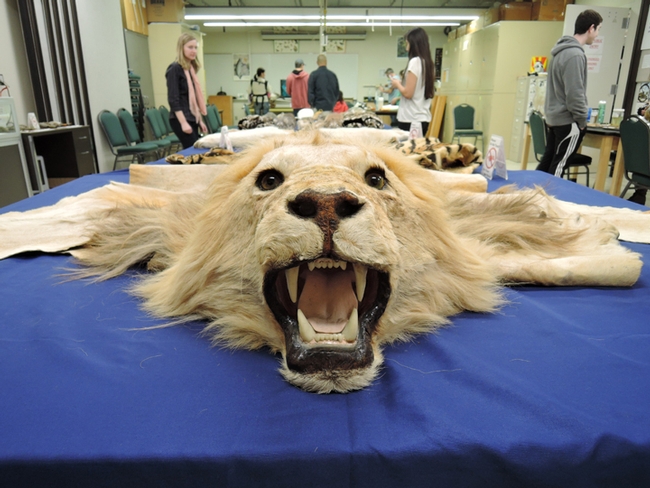
A lion specimen at the Museum of Wildlife and Fish Biology, located in Room 1394 of the Academic Surge Building. (Photo by Kathy Keatley Garvey)
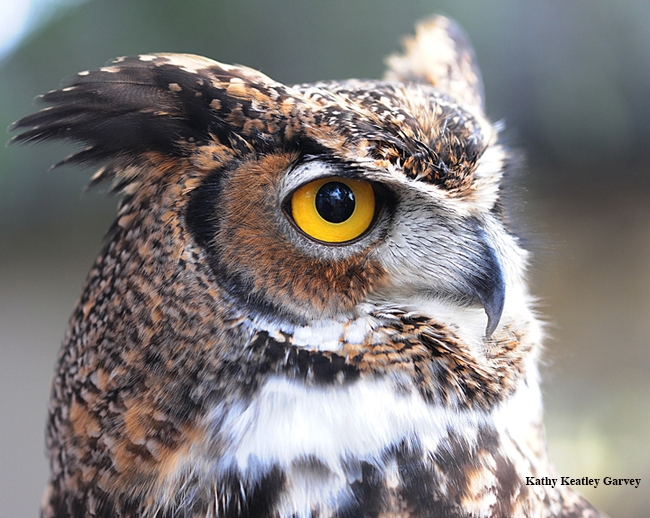
A great-horned owl at the California Raptor Center, located at 1340 Equine Lane, Davis. (Photo by Kathy Keatley Garvey)